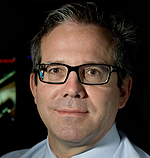December 11, 2011 - By John Sanford

Geoffrey Gurtner
Researchers at the Stanford University School of Medicine report that they have identified the molecular pathway through which physical force contributes to scarring in mice.
“Our study exposes one of the fundamental mechanisms by which the mechanical environment can directly increase inflammation, which is strongly implicated in scarring,” said Geoffrey Gurtner, MD, professor and associate chair of surgery.
Mice genetically engineered to lack an enzyme that is activated by mechanical force demonstrated less inflammation and fibrosis — the formation of excess fibrous connective tissue — in their incisions than mice in a control group, the study found. Inflammation and scar formation also were reduced among mice injected with an organic compound, a small molecule called PF-573228, that blocks this enzyme, which helps cells sense changes in the mechanical environment.
While further testing is needed to determine the validity of the findings in humans, the researchers say they hope their work will pave the way for new treatments of fibrotic diseases — disorders caused by scarring, such as pulmonary fibrosis (the buildup of scar tissue in the lungs) — as well as inflammatory diseases, such as rheumatoid arthritis.
The study was published online Dec. 11 in Nature Medicine. Gurtner is the senior author. The lead author is postdoctoral scholar Victor Wong, MD.
Inflammation, an important part of healing, occurs when white blood cells and the chemicals they release try to kill bacteria and eat up damaged tissue at the site of an injury. However, inflammation is also linked to scarring. And while there are chemical mechanisms that lead to inflammation, mechanical forces generally have been overlooked as a key stimulator of this biological response and as a possible therapeutic target, the researchers say. An example of such a force would be the pulling on an incision when a patient moves; it’s the reason stitches are sometimes needed.
“We just haven’t taken the physical environment — the environment of mechanical forces that hold all our cells together — seriously enough as a source of inflammation and fibrosis,” Gurtner said.
Previous studies have implicated the enzyme, known as focal adhesion kinase, in cellular responses to force, but whether it played a role in inflammation and scarring remained unclear. When the researchers had it genetically engineered out of mice for the current study, incisions in those mice healed normally but scarring was markedly diminished. Ten days after the mice sustained a skin incision, 48 percent fewer scar-tissue cells had formed around it compared with incisions in a control group, according to the study.
The researchers found that the enzyme appears to modulate protein molecules often used by cells to communicate with one another. In test tube studies, mouse scar tissue missing the enzyme did not respond normally to mechanical stimuli and released far lower levels of inflammatory mediators.
The researchers also tested the effects of the enzyme-inhibiting molecule (PF-573228) on human cells that play a key role in wound healing and found that the molecules that stimulate inflammation were not released.
Tests on humans are needed before researchers can evaluate whether this approach could serve as the basis for a valid therapy. The researchers said they hope their findings can eventually be used to develop treatments for diseases that involve scarring. “These results suggest that targeted strategies to uncouple mechanical force from inflammation and fibrosis may prove clinically successful across diverse organ systems,” they concluded.
Other Stanford co-authors were Michael Longaker, MD, MBA, the Deane P. and Louise Mitchell Professor at the School of Medicine; Satoshi Akaishi, MD, a visiting surgeon from Japan; postdoctoral fellows Michael Sorkin, MD, Kemal Levi, MD, and Jason Glotzbach, MD; bioinformatics student Michael Januszyk, MD; and medical students Emily Nelson, Kristine Rustad, Josemaria Paterno and Ivan Vial.
The study was funded by grants from the Armed Forces Institute of Regenerative Medicine and the Oak Foundation. Information about Stanford’s Department of Surgery, which also supported the work, is available at http://surgery.stanford.edu.
About Stanford Medicine
Stanford Medicine is an integrated academic health system comprising the Stanford School of Medicine and adult and pediatric health care delivery systems. Together, they harness the full potential of biomedicine through collaborative research, education and clinical care for patients. For more information, please visit med.stanford.edu.